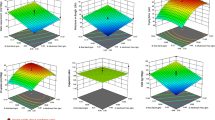Abstract
A dume-buchu (Allium senescens L.) cracker with retrograded rice powder was developed for consumption as a children’s snack. For product development, the response surface methodology was used. Market tests using a questionnaire administrated to children and their caregivers were implemented. To evaluate the product’s quality during storage, chemical, sensory, and microbiological tests were tested. Optimal mixing ratios of the recipe were determined as 22.4% retrograded rice and 11.4% dumebuchu. During storage, the color of the product changed to lighter and adhesiveness of the product (p<0.001) increased. Escherichia coli, coliform, and Bacillus cereus were not detected during 13 days, which satisfies the Guidelines of the Food Code Standard of Korea. Consumer in market tests rated the top 2 attributes of the cracker as nutritional value and health. Based on these results, the dume-buchu cracker may have positive impacts as a children’s snack.
Similar content being viewed by others
References
Englyst HN, Kingman SM, Cummings JH. Classification and measurement of nutritional important starch fractions. Eur. J. Clin. Nutr. 46: S33–S50 (1992)
Perera A, Meda V, Tyler RT. Resistant starch: A review of analytical protocols for determining resistant and of factors affecting the resistant starch content of foods. Food Res. Int. 43: 1959–1974 (2010)
Kim KN, Kim MY, Kim EJ, Park SM, Hong JS, Cho JS. Dietary behaviors and snack consumption of primary school children in Chungbuk area. Hum. Ecol. Rev. 10: 241–250 (2007)
Chung H, Eum Y, Kim J. A study on the children’s eating habit and food preference according to their parents’ economic status (I): Seoul and Gyeonggi (Incheon) area. Korean J. Nutr. 41: 77–88 (2008)
McCann D, Barrett A, Cooper A, Crumpler D, Dalen L, Grimshaw K, Kitchin E, Lok K, Porteous L, Prince E, Sonuga-Barke E, Warner JO, Stevenson J. Food additives and hyperactive behavior in 3-year-old and 8/9-year-old children in the community: A randomized, double-blinded, placebo-controlled trial. Lancet 370: 1560–1567 (2007)
Kim Y, Chang H. Correlation between attention deficit hyperactivity disorder and sugar consumption, quality of diet, and dietary behavior in school children. Nutr. Res. Pract. 5: 236–245 (2011)
USDA and USHHS. Dietary Guideline for Americans. 8th ed. U.S. Department of Agriculture and U.S. Department of Health and Human Services, Washington, DC, USA. p. 82 (2010)
Lee J, Park H, Park S. A survey on eating behaviors of preschool children for development snack. Korean J. Food Culture 18: 151–159 (2003)
Kim JS, Shin M. Quality characteristic of cookies with resistant starches. Korean J. Food Cookery Sci. 23: 659–665 (2006)
Aigstera A, Duncan SE, Conforti FD, Barbeau WE. Physicochemical properties and sensory attributes of resistant starch-supplemented granola bars and cereals. LWT-Food Sci. Technol. 44: 2159–2165 (2011)
Ha AW, Han GJ, Kim WK. Effect of retrograded rice on weight control, gut function, and lipid concentrations in rats. Nutr. Res. Pract. 6: 16–20 (2012)
Ozboy-Ozbas O, Seker IT, Gokbulut I. Effects of resistant starch, apricot kernel flour, and fiber-rich fruit powders on low-fat cookie quality. Food Sci. Biotechnol. 19: 979–986 (2010)
Korea National Arboretum. Illustrated Rare and Endangered Species in Korea. Korea National Arboretum. Pocheon, Korea. p. 37 (1997)
Kim TJ. Korean Resources Plants. University Press, Seoul, Korea. p. 150 (1998)
Nath A, Chattopadhyay PK. Optimization of oven toasting for improving crispness and other quality attributes of ready to eat potato-soy snack using response surface methodology. J. Food Eng. 80: 1282–1292 (2007)
Wadikar DD, Nanjappa C, Premavalli KS, Bawa AS. Development of ginger based ready-to-eat appetizer by response surface methodology. Appetite 55: 76–83 (2010)
Joo SY, Kim HJ, Pail JE, Joo NM, Han YS. Optimization of muffin with added spinach powder using response surface methodology. Korean J. Food Cookery Sci. 22: 45–55 (2006)
RDA National Academy of Agricultural Science. 8th Revision Food Composition Table. Rural Development of Administration National Academy of Agricultural Science. Kwangmoondang, Seoul, Korea. pp. 28, 148 (2011)
Korea Food & Drug Administration. Food Code. Available from: http://www.foodnara.go.kr/portal/site/kfdaportal/infotelegram/. Accessed Sept. 10, 2011.
Food and Drug Administration. Food Code 2009: US Public Health Service. US Dept. of Health and Human Service, Washington, DC, U.S. Available from: http://www.fda.gov/Food/FoodSafety/RetailFoodProtection/FoodCode/FoodCode2009/default/htm. Accessed Sept. 10, 2011.
KFDA. Food Code. 10-1-7, 10-1-9, 10-1-19, 10-1-33, 10-1-40, 10-1-46, 10-1-51, 10-1-56, 10-1-61, Korea Food and Drug Administration, Seoul, Korea (2011)
Hwang CW, Shin HK, Do MS, Kim YJ, Park JH, Chio YS, Joo WH. The various biofunctional effects (anticarcinogenic, antioxidative, and lypolytic activity) of Pohang buchu. Korean J. Food Sci. Technol. 33: 279–281 (2001)
Park KB, Han GH, Kim BY. Utilization of the natural antioxidants for the anti-peroxidation of almond cracker. J. Korean Soc. Food Sci. Nutr. 32: 131–136 (2003)
Kim JS, Kang KJ. Effect of laminaria addition on the shelf-life and texture of bread. Korean J. Food Nutr. 11: 556–560 (1998)
Heo YJ, Sim KH, Choi HY, Kim SI. Antioxidative activity of crackers made with a guava (Psidium guajava Linn.) leaf extract harvested in Korea. Korean J. Food Cookery Sci. 26: 171–179 (2010)
Lim EJ, Huh CO, Kwon SH, Yi BS, Cho KR, Shin SG, Kim SY, Kim JY. Physical and sensory characteristics of cookies with added leek (Allium tuberosum Rottler) powder. Korean J. Food Nutr. 22: 1–7 (2009)
Author information
Authors and Affiliations
Corresponding author
Rights and permissions
About this article
Cite this article
Chang, H., Ha, K., Lim, J. et al. Development of dume-buchu (Allium senescens L.) cracker with retrograded rice for children snacks. Food Sci Biotechnol 21, 1349–1358 (2012). https://doi.org/10.1007/s10068-012-0178-y
Received:
Revised:
Accepted:
Published:
Issue Date:
DOI: https://doi.org/10.1007/s10068-012-0178-y




